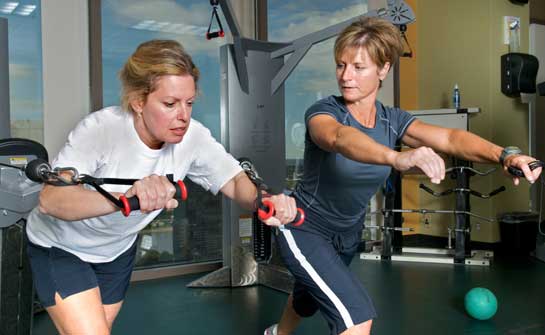
By KAREN ASP
Your clients are a lot like books. They can’t be easily judged by their covers, and they’re usually not an easy read. Trouble is, if you’re evaluating them only from the physical side of things, you could be doing your career—and your clients—a disservice.
Granted, your exercise knowledge may encourage clients to work harder on a treadmill or throw down a few more reps in the weight room, but will any of this help them make lifelong changes? If you’re not addressing the whole individual, then it probably won’t. Yet by learning how to address more than just the physical needs of your clients, you could secure their success—and yours—well into the future.
The Evolution of the Personal Trainer
The idea of training the whole individual is not a new concept. It is, after all, what personal training was founded on. “It’s called personal training for a reason,” says Cedric Bryant, Ph.D., chief science officer for the American Council on Exercise. “Sometimes, fitness professionals think it’s all about numbers, programming and exercise technique, and while these are still important, if you don’t focus on the interpersonal side of things, your programs will be lacking.” Bryant adds, for instance, that you need to learn how to establish a personal connection with clients, know appropriate communication strategies so you can create a rapport with clients, and establish credibility and trust with clients so they can make necessary behavioral changes that will drive their long-term success.
The way Dave Reddy, M.S., ACE-certified Lifestyle & Weight Management Coach and owner of S.A.F.E. Fitness Solutions in St., Louis, Mo., sees it, personal training is undergoing an evolution—from trainer to coach—and whether you decide to join the movement depends on your goals. “If you want to work with highly motivated individuals who are looking to improve their fitness, then it’s fine to stick with the science and performance aspects as a personal trainer,” he says. “But if you want to address the 60 percent of the population that’s overweight and obese, you have to address behavioral changes, which is where coaching comes into play.”
Reddy hits on an important point: The number of highly motivated, regular exercisers is shrinking rapidly, only to be replaced by a sedentary, overweight population. While you’ll no doubt always have the die-hard fitness enthusiasts, they are becoming a rare breed. Therefore, if you want to restock your client base, it might be a wise career move to take coaching’s whole-life approach to working with clients and learn how to address behavioral changes.
The coaching approach is something Pamela Hernandez, ACE-certified Lifestyle & Weight Management Coach, certified personal trainer and owner of Thrive Personal Fitness in Springfield, Mo., believes every trainer needs to have to be successful. “You can put together an exercise program and advise a client to exercise so many times a week,” says Hernandez, who overcame her own weight issues by dropping about 30 pounds. “But if you don’t understand your client’s mental and physical challenges and where they are in their life, you can’t help them change.”
Learning How to Address the Whole Individual
Of course, this begs an obvious question: How does a personal trainer develop coaching skills? Fortunately, ACE has provided a solution by offering the Lifestyle & Weight Management Coach (LWMC) certification. As you may remember from previous articles in ACE Certified News, the certification broadens your scope as a fitness professional, teaching clients how to make lifestyle changes by addressing the whole individual.
Consider the experience of Dan Houston, president of Houston Fitness in Highland and Clarkson, Mich. Before Houston obtained the ACE LWMC certification, he was doing old-school personal training with his clients. Yet with the knowledge and skills he has acquired as an ACE-certified LWMC, he’s been able to address more than just the physical needs of his clients, which has led to increased success. For instance, he can now help clients wade through their nutritional pitfalls. “All of my clients appreciate that I can do more than just take them through their workouts,” he says. “I’m helping them change their lives.” In fact, Houston attributes the 20 percent increase he saw in business last year to this coaching mentality he’s taken with clients.
Of course, without the LWMC certification, you’re more limited in how you can help clients, and you need to adhere to the parameters of your current certification. But that doesn’t mean you can’t brush up on your knowledge of other skills that will help clients move forward.
In addition to earning a secondary certification, consider focusing your continuing education on courses that will help you improve your communication skills, including your listening skills. “Many trainers get so excited to impart their knowledge to clients that they forget to listen to clients,” Bryant says.
You should also look for classes that teach you about the different stages of change, which simply pinpoint how ready people are to change. Knowing this can help you plot the best program for your clients. “If I see somebody in the contemplation stage where they’re trying to figure out what they want to do and how to do it, I approach them differently than if I’m working with somebody who’s in the action stage and has been exercising for two or three months,” Reddy says.
Getting Inside the Mindset of the Overweight Individual
Of course, if you’ve never been overweight, it can extremely difficult to understand what your weight-challenged clients are facing, no matter how many certifications you obtain. And this makes it more difficult to know how to address all of their needs. “It’s like trying to describe having a baby to somebody who’s never had one,” says Cedar McCrary, founder and head trainer of CedarFIT Personal Training in Albuquerque, N.M. McCrary became a personal trainer after losing 75 pounds and then added the LWMC certification to her credentials. “However, if you can gain a better perspective and bring compassion and empathy to your clients, you’ll have greater success working with them.”
In McCrary’s ideal world, every trainer would have to wear a fat suit so they could understand how differently people treat you. “When you’re fat, other people discount you completely, which can be devastating,” she says. On the flip side, though, overweight individuals often use the excuse that they can’t do something because they’re too heavy. However, McCrary doesn’t think clients should be allowed to use that as an excuse. Instead, she suggests, “learn how to pull them out of their shell.”
There is also a perception that overweight people are lazy. “I've heard many trainers pass judgment on overweight individuals, accusing them of being lazy or lounging on their couch,” McCrary says. Yet this isn’t always true, which is why McCrary advocates stepping away from these stereotypes and seeing past the weight. “Don’t look at these clients as fat individuals, but rather as people who need to change their habits.”
It is also important to realize that exercise can be a terrifying and emotionally difficult experience for some people, especially those who have struggled with weight. “They may have some emotional trauma from past exercise experiences, which is why you need to recognize that taking small steps like coming to see you each week or stepping foot in the gym for the first time are major accomplishments for some people,” Hernandez says.
Finally, remember that for many individuals, weight is a highly charged issue, often bringing with it strong emotions. “I keep tissues in my studio, and while I don’t try to make people cry, sometimes when we start talking about issues around food and feelings of failure, clients often get emotional, especially if they’ve been struggling with self-image and pressure from friends and family for a long time,” says Hernandez, adding that she’s seen many trainers gloss over the emotional side of weight loss.
Training the whole individual will no doubt take more work on your end, but in the end, it could make you a better, more successful fitness professional. “I see lots of trainers who are struggling because they don’t understand that they need to approach the whole person,” Hernandez says. “Instead, they see only half a body, which may be why their business is only doing half as well as it could be.”
__________________________________________________________________________

Karen Asp, freelance journalist and ACE-certified Fitness Professional, is a contributing editor for Woman’s Day and the Fit Travel columnist for AOL. She also writes regularly for numerous other publications, including Self, Fitness, Women’s Health, Better Homes and Gardens, Real Simple, Prevention, Runner’s World, Redbook and Men’s Fitness.